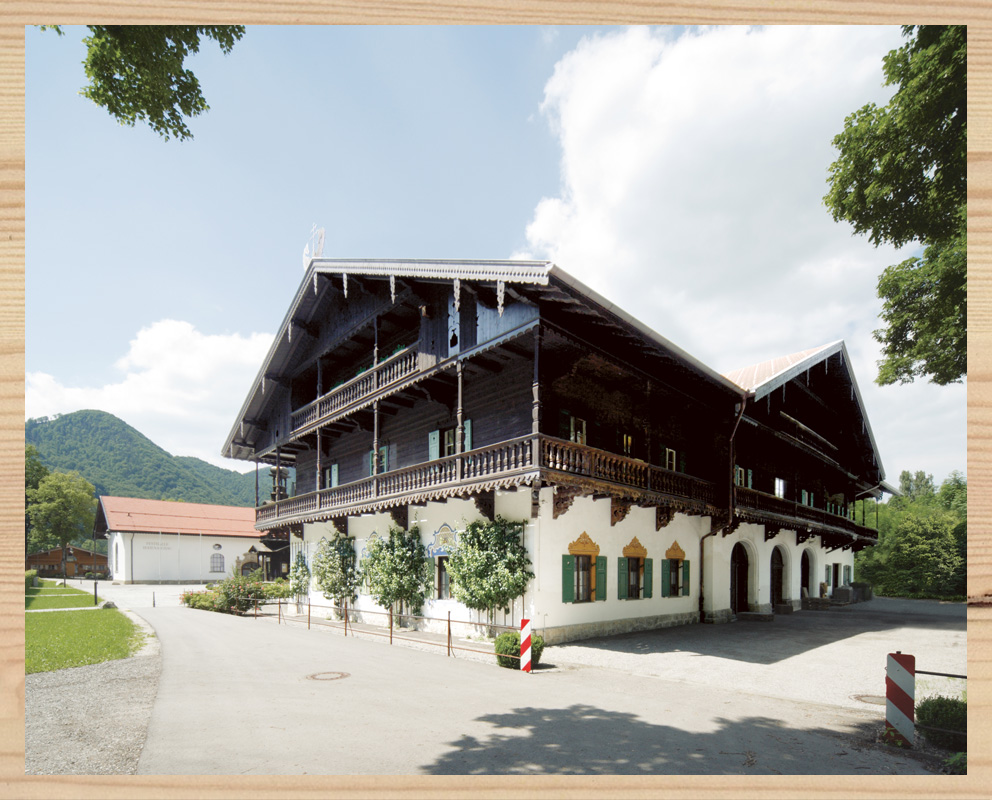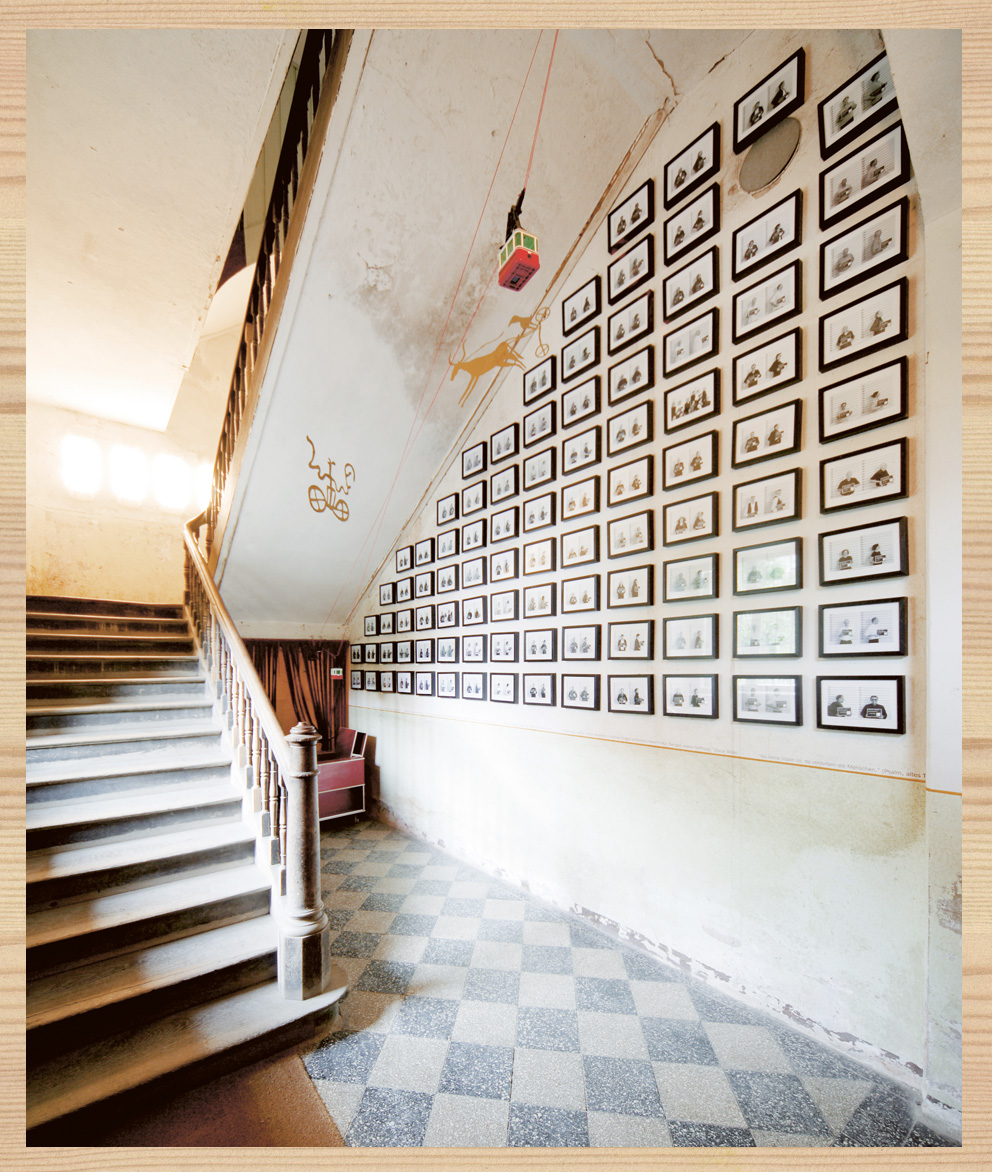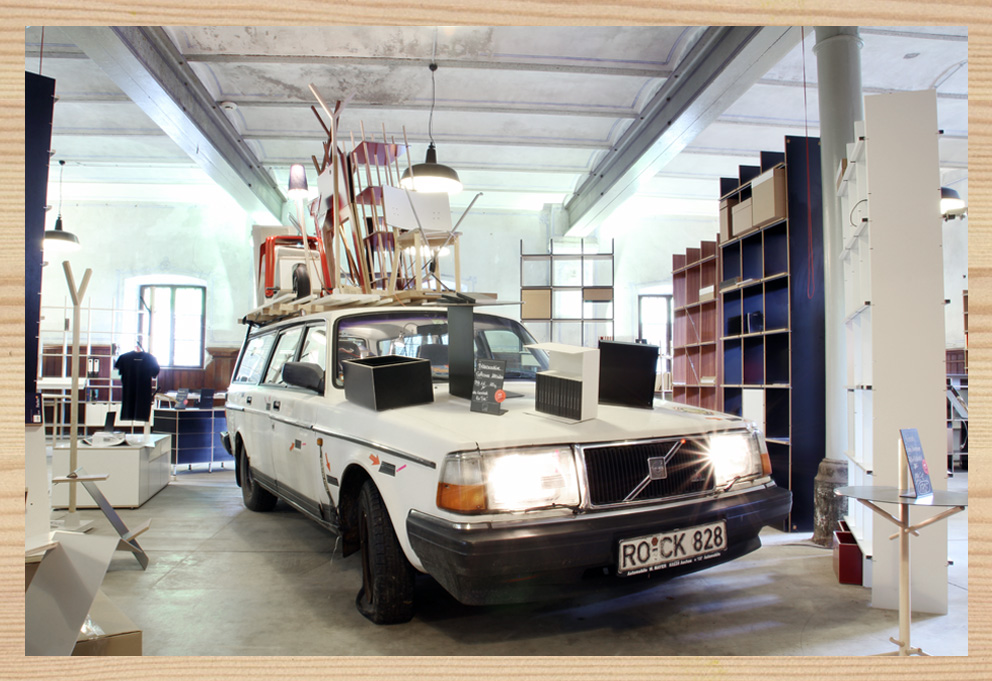
Ladies and Gentlemen!
Yes, you can believe your ears.
If you were to telephone the entrepreneur who is being honored here today you would get to hear precisely these sounds, making you dream of your next holiday rather than preparing for a tough business call, with sales figures, commissions, margins and all that other stuff discussed in the trade world.
You have been listening to the bells of cattle in Alpine pastures, which admittedly aren’t located exactly behind the company headquarters in Hohen-Aschau, but are still considered part of Upper Bavaria.
Ladies and Gentlemen,
The phenomenon of Nils Holger Moormann is not an easy one to describe, even less so with words. So having been director of the design museum at Munich’s Pinakothek der Moderne I resolved to rely on an ancient trick in art history, which says: If you have nothing to say, then do an illustrated talk and use pictures to communicate to the audience a visual idea, whether you are talking about a painting or an outstanding personality, which is what we are doing here today. And so I ventured down into the archives of the company and of my private home in a bid to retrieve those very pictures that I am hoping will bring the entrepreneurial mindset of Nils Holger Moormann a little closer to you today.

This first picture of Moormann as a young boy makes for a striking opening. Despite his slightly dreamy demeanor, he has already developed his vision of the future.
Things are looking a bit different today: Business has evidently toughened him up, as have, to use a euphemism, his dealings with Italy. In short, our entrepreneur is a capo now.
Please do not let yourselves be misguided by the company location of Hohen-Aschau and the cling-a-linging you heard at the beginning – Nils Holger Moormann, who was born in 1953 in Stuttgart, is not of Bavarian extraction.
His father was from Westphalia and his mother came from Hamburg – which no doubt explains his first name, “Nils”. And this story once again testifies to the generosity of the Free State of Bavaria, which has so graciously granted a man of his origins, who failed to complete his Law degree to boot, residence in this most beautiful of German states.
Mind you, the worst is yet to come. Nils Holger Moormann started his company in Aschau in the early 1980s before relocating to the nearby village of Hohen-Aschau a decade later, having finally found a prestigious company base there that aptly reflected the quality of his products. And should you ever decide to pay Mr. Moormann and his company a visit, you will be sure of a very warm and friendly welcome, and we would not expect it any other way.

You are greeted by flags showing, well, cows’ behinds. You have to make your way past security ...

before you get to the heart of this international company.

On the “Wall of Blame” in the lobby you come face to face with all ...

those comrades in crime with whom Nils Holger Moormann has had dealings with. And, as you can see, ...

they are evidently of different height. The maximum height has been set at 2.10 m, but it has never been reached ...

– even with the help of a hat.

Once you have walked along this collection most-wanted faces you get to a welcoming counter with a charming receptionist whom you must greet with a smile, as otherwise that door will most probably remain closed.
Thanks to its trailblazing overall design, the company building is considered a milestone in 21st-century architecture. The same holds true of the company fleet.

Here you see the car of the company boss as he visits a client to showcase the latest products. Special consideration went into the car’s license plate, which is RO-CK.

But the company fleet is very versatile. Here we see the entrepreneur making his way to a presentation of “German Design” in Aspen, Colorado, which was initiated by Herbert Schultes and hosted by the Munich Design Center in the mid-1990s. As I already mentioned, today’s market is highly international – indeed it extends to the end of the world.
It all began in the early 1980s, when Nils Holger Moormann decided to become an entrepreneur and establish a furniture production and retail company, precisely at a time when German designers, 10 to 15 years after their Italian counterparts, who masterminded such beauties as “Alchimia” and “Memphis”, finally realized that right angles and the roaring mousey gray of Ulm’s School of Design were not the be-all and end-all. This was the era of “New German Design” which, with its garish and at times outlandish concepts, not only drove old-established furniture makers to despair with exhibitions such as “Möbel Perdu” or “Kaufhaus des Ostens”, but equally so the German Design Council. As well as – and I readily admit it – the one or other design museum, including my own former institute. And so it comes as no surprise that under the names of “Kollektion International” and “Memphis”, Nils Holger Moormann sold furniture by the likes of Ettore Sottsass and Michele de Lucchi, as well as luminaires by the Swiss company Belux, not to forget furniture by Thut. Nonetheless, the output of “New German Design” was unable to find a market or producer, and it was Nils Holger Moorman who took these designs under his wing, albeit in the capacity of a furniture dealer, not a furniture producer in the traditional sense. At the time the reinterpretation of company roles was an epiphany, for it enabled Nils Holger Moorman to respond swiftly and actively, circumventing the problem of having to produce in large batch numbers, which is detrimental to the balance sheets.
Quite remarkably, many of those designers are no longer around. Some of them have opted for academic careers and now teach at design academies as professors, while the best of them are still having their designs produced by Nils Holger Moormann – almost 30 years on.

And so the entrepreneur’s catalogues proudly feature a shelf by Mr. Laubersheimer that is still being produced today, whose tautness arguably wrote design history. Here you see steel brackets transformed into candle holders by casting them in concrete, which also went into production. The Fauxpax boys who are responsible for the design had the wisdom not to bother with design training proper, but had their pieces produced straight from their college art class.

And because it was such a success, Nils Holger Moormann also produced a dresser on which you could play with your toy train. It made for the highlight at any design auction – we should have ordered more products from Nils Holger Moormann back then.
Handelsblatt newspaper devoted an entire article to the “Deutsche Bank” (German bench), which Moormann sold at his company, and succeeded in making the design a topic of hot debate and media attention even outside expert circles.
That said, this also earned Moormann a scathing review from another important design institution, namely in the preface to the Design Yearbook of that particular year. It was not exactly to his detriment however, and today he has quite a considerable number of red dots under his belt.

His pieces of furniture could stand on very shaky feet or have a philosophical air about them, ...

or be reinterpreted as pictures or put to a new use – not drying hay but hanging clothes, ...

or serve as special furnishing for football clubs, ...

or ultimately demonstrate perfect German design once again – precise, functional, and in black and white.

Here you can see what we call the “instigators”, namely those designers who pointed the company in the right direction with their ideas.
Countless “Incentive” events were held to convince clients of the quality of the products.

And the whole thing went by the name of “Hell of Aschau”.
For the senior client base events were hosted that were a great deal more pleasant and civilized, as you can see from the following pictures.

Be it Thomas Edelmann, Alfredo Häberli or Axel Kufus, each with their own cake creations.

And here comes the latest craze: For those clients who find attending product presentations too stressful there is now a special care center, which goes by the name of “berge” and is just around the corner from the company headquarters, boasting a perfectly appointed reception desk and rooms ...

encouraging cozy and enduring togetherness, if necessary with bunk beds.
Ladies and Gentlemen,
Now that I have taken you through my illustrated lecture you will agree that for his entrepreneurial achievements Nils Holger Moormann more than deserves being presented with the German Design Award.
And you can take a peek at the modest round-up of previous distinctions:

The spot in which the certificate will hang is already designated by the red curtain –
and the wording is set.
Dear Nils Holger Moormann – many congratulations!
Ladies and Gentlemen, thank you for your attention.
Dr. Florian Hufnagl worked for 34 years for the Neue Sammlung - The international design museum in Munich, from 1980 on as curator, from 1990 on as the director. Hufnagl studied fine arts, archaeology and history. He did his doctor degree in 1976 researching on architecture of the 19th century.










